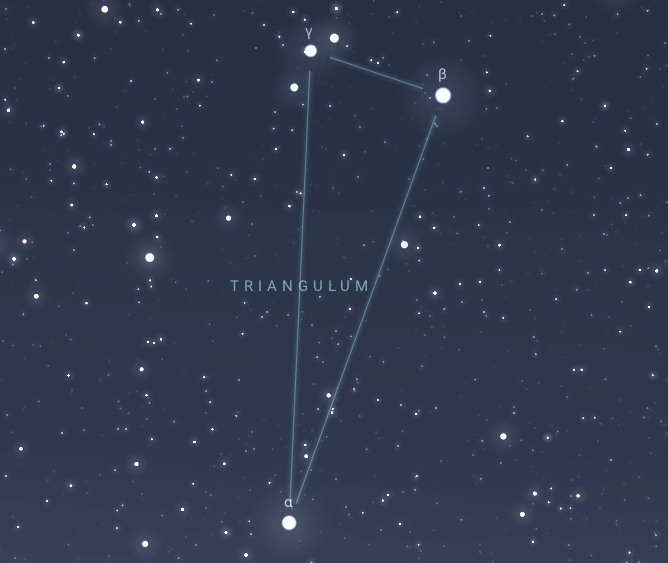Triangulum is a small but distinctive constellation in the northern sky, aptly named for its triangular shape formed by three principal stars. Though it lacks the dramatic lore of more prominent constellations, Triangulum holds its own in both structure and astronomical interest, particularly due to the presence of a notable galaxy. Its simplicity makes it one of the more easily recognizable constellations in a dark sky.
Shape
Triangulum’s shape is defined by a compact triangle made up of three moderately bright stars: Alpha Trianguli (Mothallah), Beta Trianguli (Ras Al Muthallah), and Gamma Trianguli. These stars form a clear isosceles triangle that stands out against the fainter surrounding star field. The constellation’s compactness and geometric clarity make it a helpful marker in the sky for amateur astronomers scanning the region near Andromeda and Aries.
Mythology
Although part of Ptolemy’s original list of 48 constellations from the 2nd century, the constellation does not feature prominently in classical mythology. It was occasionally associated with the Nile Delta or Sicily in various traditions, but it lacks the rich mythological narratives that characterize many neighboring constellations. Its enduring presence in star charts, however, reflects its importance in the early categorization of the sky.
Location
Located in the northern celestial hemisphere, Triangulum is nestled between Andromeda to the northwest and Aries to the southeast. Although its stars are not among the brightest in the sky, the constellation can be observed with the naked eye under dark, clear conditions. Its modest brightness does not detract from its usefulness in celestial navigation or its appeal to dedicated observers.
Deep-Sky Objects
The constellation is best known for housing the Triangulum Galaxy (Messier 33 or M33), one of the most prominent spiral galaxies in the night sky. Situated approximately 2.73 million light-years from Earth, M33 is the third-largest galaxy in the Local Group, following the Andromeda Galaxy (M31) and the Milky Way. Under excellent viewing conditions, it is just visible to the naked eye as a faint smudge, but binoculars or a small telescope reveal its spiral structure and star-forming regions. This makes the constellation valuable for those interested in extragalactic observation.
Observation
Triangulum is most easily observed during the autumn and winter months in the Northern Hemisphere, particularly from September through February. During this period, it rises in the eastern sky in the early evening and slowly arcs westward through the night. The constellation reaches its highest point in the sky during the late evening to early morning hours, offering the best viewing window. While its triangular pattern can be discerned with the unaided eye, optical aids greatly enhance the view, especially for locating M33 and appreciating the finer points of the star field.
Despite its small size, Triangulum remains an intriguing and rewarding target for stargazers. Its simple geometric form and the presence of a major galaxy make it both accessible to beginners and compelling for more experienced observers. While not as showy as some constellations, it offers a quiet elegance and a window into the broader cosmos.

Star Magnitudes
Here are the magnitudes of some notable stars in the Triangulum constellation:
Alpha Trianguli (Mothallah) – Magnitude: 3.41
Beta Trianguli (Ras Al Muthallah) – Magnitude: 3.00
Gamma Trianguli – Magnitude: 4.00



